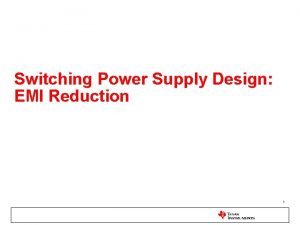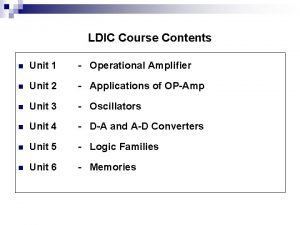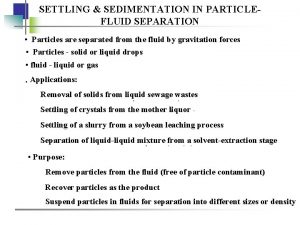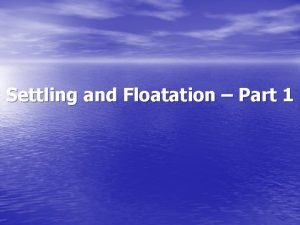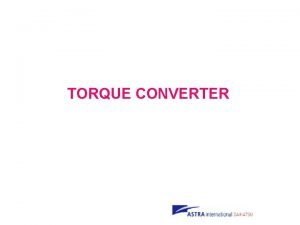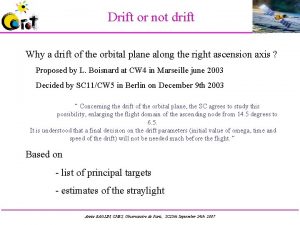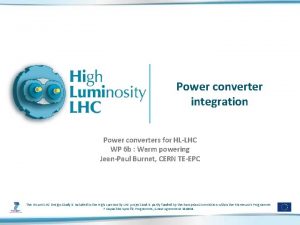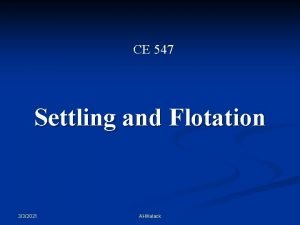HLLHC power converter requirements Thermal settling drift Miguel




![HL-LHC Power converter requirements • 5 Resolution [ppm] Initial uncertainty after cal [2 xrms HL-LHC Power converter requirements • 5 Resolution [ppm] Initial uncertainty after cal [2 xrms](https://slidetodoc.com/presentation_image_h/aec04d715fbfb3ed9d64d3d271e0705b/image-5.jpg)




- Slides: 9

HL-LHC power converter requirements Thermal settling drift Miguel Bastos 153 rd WP 2 meeting - CERN - 6/R-012 – 03/07/2019

HL-LHC Power converter requirements 2 • Requirements were revised and approved this year, new version of CERN-ACC-2017 -0101 document to be released • As a reminder, values and definitions of some parameters were revised, and the effect of temperature considered separetely, as shown below Resolution [ppm] Initial uncertainty after cal [2 xrms ppm] normal Linearity [ppm] [max abs ppm] uniform Stability during a fill (12 h) [max abs ppm] uniform Short term stability (20 min) [2 xrms ppm] normal Noise (<500 Hz) [2 xrms ppm] normal Fill to fill repeatability [2 xrms ppm] normal Long term fill to fill stability [max abs ppm] uniform Temperature coefficient [max abs ppm/C] uniform 12 h Delta T for HL-LHC [max C] constant 1 y Delta T for HL-LHC [max C] constant PC REQUIREMENTS SUMMARY - ACCURACY CLASSES 0 1 2 3 4 0. 5 1. 0 2. 0 3. 0 7. 0 10. 0 2. 0 5. 0 8. 0 9. 0 0. 7 1. 9 5. 0 8. 0 9. 5 0. 2 0. 4 1. 2 2. 0 5. 0 3. 0 5. 0 7. 0 15. 0 19. 0 0. 4 0. 8 2. 6 4. 0 5. 0 8. 0 19. 0 40. 0 45. 0 1. 2 2. 5 5. 5 6. 5 0. 5 1. 0 5. 0 Stability during a fill (12 h) [2 xrms ppm] Fill to fill repeatability [2 xrms ppm] long term fill to fill stability [2 xrms ppm] 0 1. 0 0. 7 9. 3 1 2. 6 1. 6 9. 3 2 15. 5 14. 7 26. 3 3 33. 1 32. 0 56. 1 4 39. 1 37. 9 64. 1

HL-LHC Power converter requirements 3

HL-LHC Power converter requirements 4 • The final values are presented in 2 x RMS. resulting in the final table shown below. . PC REQUIREMENTS SUMMARY - ACCURACY CLASSES 0 1 2 3 4 Resolution [ppm] 0. 5 1. 0 Initial uncertainty after cal [2 xrms ppm] normal 2. 0 3. 0 7. 0 10. 0 Linearity [ppm] [max abs ppm] uniform 2. 0 5. 0 8. 0 9. 0 Stability during a fill (12 h) [2 xrms ppm] 1. 0 2. 6 15. 5 33. 0 39. 0 Short term stability (20 min) [2 xrms ppm] normal 0. 2 0. 4 1. 2 2. 0 5. 0 Noise (<500 Hz) [2 xrms ppm] normal 3. 0 5. 0 7. 0 15. 0 19. 0 Fill to fill repeatability [2 xrms ppm] 0. 7 1. 6 14. 5 32. 0 38. 0 Long term fill to fill stability [2 xrms ppm] 9. 5 26. 5 56. 0 64. 0 • The distributions and limits of the parameters impacted by the temperature variation change with respect to the previous table. Details in EDMS doc 2048827
![HLLHC Power converter requirements 5 Resolution ppm Initial uncertainty after cal 2 xrms HL-LHC Power converter requirements • 5 Resolution [ppm] Initial uncertainty after cal [2 xrms](https://slidetodoc.com/presentation_image_h/aec04d715fbfb3ed9d64d3d271e0705b/image-5.jpg)
HL-LHC Power converter requirements • 5 Resolution [ppm] Initial uncertainty after cal [2 xrms ppm] normal Linearity [ppm] [max abs ppm] uniform Stability during a fill (12 h) [max abs ppm] uniform Short term stability (20 min) [2 xrms ppm] normal Noise (<500 Hz) [2 xrms ppm] normal Fill to fill repeatability [2 xrms ppm] normal Long term fill to fill stability [max abs ppm] uniform Temperature coefficient [max abs ppm/C] uniform 12 h Delta T for HL-LHC [max C] constant 1 y Delta T for HL-LHC [max C] constant PC REQUIREMENTS SUMMARY - ACCURACY CLASSES 0 1 2 3 4 0. 5 1. 0 2. 0 3. 0 7. 0 10. 0 2. 0 5. 0 8. 0 9. 0 0. 7 1. 9 5. 0 8. 0 9. 5 0. 2 0. 4 1. 2 2. 0 5. 0 3. 0 5. 0 7. 0 15. 0 19. 0 0. 4 0. 8 2. 6 4. 0 5. 0 8. 0 19. 0 40. 0 45. 0 1. 2 2. 5 5. 5 6. 5 0. 5 1. 0 5. 0 Stability during a fill (12 h) [2 xrms ppm] Fill to fill repeatability [2 xrms ppm] long term fill to fill stability [2 xrms ppm] 0 1. 0 0. 7 9. 3 1 2. 6 1. 6 9. 3 2 15. 5 14. 7 26. 3 3 33. 1 32. 0 56. 1 4 39. 1 37. 9 64. 1 The performance of power converters described above is essentially defined by: • ADCs (Analogue to digital conversion), DCCTs (current measurement) and Current regulation loop -> Low Frequency • Voltage source and load -> Medium and high frequency

HL-LHC Power converter requirements 6 Therefore. . . • Performance requirements for the power converter translate into even tighter performance requirements for ADCs and DCCTs. • For example, class 0 requirement for 12 h stability of a power converter is 0. 7 ppm and for the DCCT it is 0. 5 ppm. Resolution [ppm] Initial uncertainty after cal [2 xrms ppm] normal Linearity [ppm] [max abs ppm] uniform Stability during a fill (12 h) [max abs ppm] uniform Short term stability (20 min) [2 xrms ppm] normal Noise (<500 Hz) [2 xrms ppm] normal Fill to fill repeatability [2 xrms ppm] normal Long term fill to fill stability [max abs ppm] uniform Temperature coefficient [max abs ppm/C] uniform total PC 0. 5 2. 0 0. 7 0. 2 3. 0 0. 4 8. 0 1. 0 Class 0 FGC 3. 2 -EXT-AC-D 0 dcct adc 0. 2 1. 0 0. 5 0. 2 0. 1 2. 0 1. 0 0. 3 0. 1 4. 0 0. 8 0. 2 notes sum of rms sum of max sum of rms sum of max

HL-LHC Power converter requirements The DCCTs • DCCTs are power devices that measure high (e. g. 18 k. A) currents by transforming them down to smaller currents (e. g. 5 A) • A current step in the power converter corresponds to a current step in the DCCT and therefore a power dissipation step • As a consequence, a drift due to thermal settling of the resistor used to measure the DCCT output current, is more likely to happen during ther first minutes after a current step 7

HL-LHC Power converter requirements Impact for HL-LHC • The LHC ramps up the current in 10. . 20 minutes. On arrival to flat top we expect the DCCT to have higher drift in the first few minutes. • Until now : this drift was included in the 12 h stability specification, but if we exclude the initial 5 minutes after arrival to the flat top, a critical specification of the DCCT could be relaxed • It seems reasonable to assume that the machine doesn’t need to operate at full performance on arrival to the flat top (no physics), so. . . • Can we consider a period of 5 minutes were the DCCTs are allowed to settle, before they have to perform within the 12 h stability ? 8

HL-LHC Power converter requirements 9 • If yes, then the following new table is proposed, including a new specification: • Stability at the end of ramp (5 min): Variation of the delivered current (for a constant reference) during the first 5 minutes after the current reaches the flat top PC REQUIREMENTS SUMMARY - ACCURACY CLASSES 0 1 2 3 4 Resolution [ppm] 0. 5 1. 0 Initial uncertainty after cal [2 xrms ppm] normal 2. 0 3. 0 7. 0 10. 0 Linearity [ppm] [max abs ppm] uniform 2. 0 5. 0 8. 0 9. 0 Thermal settling drift - first 5 minutes of flat top [max abs ppm] uniform 0. 5 1. 5 3. 0 6. 0 Stability during a fill (12 h) [2 xrms ppm] 1. 0 2. 6 15. 5 33. 0 39. 0 Short term stability (20 min) [2 xrms ppm] normal 0. 2 0. 4 1. 2 2. 0 5. 0 Noise (<500 Hz) [2 xrms ppm] normal 3. 0 5. 0 7. 0 15. 0 19. 0 Fill to fill repeatability [2 xrms ppm] 0. 7 1. 6 14. 5 32. 0 38. 0 long term fill to fill stability [2 xrms ppm] 9. 5 26. 5 56. 0 64. 0
 Buck converter and boost converter
Buck converter and boost converter Differences between inverting and non inverting amplifier
Differences between inverting and non inverting amplifier Thermal energy section 3
Thermal energy section 3 Thermal transfer vs direct thermal printing
Thermal transfer vs direct thermal printing Ac power formula
Ac power formula Where can we find rotating arm sprays in sewage treatment?
Where can we find rotating arm sprays in sewage treatment? Hazen formula for settling velocity
Hazen formula for settling velocity Solid spherical particles of coffee extract from a dryer
Solid spherical particles of coffee extract from a dryer Differential settling method
Differential settling method Example of flotation and settling
Example of flotation and settling
